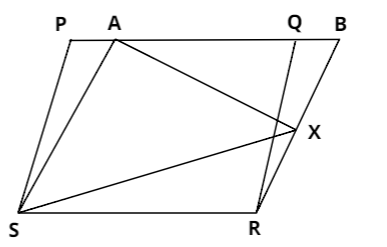
In the given figure, $PQRS$ and $ABRS$ are parallelogram and $X$ is any point on $BR$. Show that,
$(i)$area$(PQRS)$$ = $area$(ABRS)$,
$(ii)$ area$(AXS)$$ = $$\frac{1}{2}$area$(PQRS)$.


Answer
608.4k+ views
Hint: Both the parallelograms are lying on the same base and within the same parallel lines.
$(i)$Consider parallelograms $PQRS$ and $ABRS$. They are lying on the same base $RS$ and between the same parallel lines $RS$ and $PB$. And according to the property of parallelogram, we know that parallelograms lying on the same base and between the same parallel lines have equal area. Therefore:
$ \Rightarrow $ area$(PQRS)$$ = $area$(ABRS)$.
$(ii)$Now, consider $\Delta AXS$ and parallelogram $ABRS$. Both are lying on the same base $AS$ and between the same parallel lines $AS$ and $BR$. And we know that the area of the triangle having the base as a parallelogram and its third vertex lying on the opposite parallel side of the parallelogram is half the area of the same parallelogram.
$\therefore $ area$(AXS)$$ = $$\frac{1}{2}$ area$(ABRS)$
And we have already proved that, area$(PQRS)$$ = $area$(ABRS)$. Using this, we’ll get:
$ \Rightarrow $area$(AXS)$$ = $$\frac{1}{2}$area$(PQRS)$
Note: Area of a parallelogram is base times its height. So, if two parallelograms are having the same base and lying between the same parallel lines, their heights will also be the same and consequently their areas will be the same. Triangle on the other hand is having an area as half of base times its height. Therefore, a triangle having such property as mentioned above will have its area as half of the area of the parallelogram.
$(i)$Consider parallelograms $PQRS$ and $ABRS$. They are lying on the same base $RS$ and between the same parallel lines $RS$ and $PB$. And according to the property of parallelogram, we know that parallelograms lying on the same base and between the same parallel lines have equal area. Therefore:
$ \Rightarrow $ area$(PQRS)$$ = $area$(ABRS)$.
$(ii)$Now, consider $\Delta AXS$ and parallelogram $ABRS$. Both are lying on the same base $AS$ and between the same parallel lines $AS$ and $BR$. And we know that the area of the triangle having the base as a parallelogram and its third vertex lying on the opposite parallel side of the parallelogram is half the area of the same parallelogram.
$\therefore $ area$(AXS)$$ = $$\frac{1}{2}$ area$(ABRS)$
And we have already proved that, area$(PQRS)$$ = $area$(ABRS)$. Using this, we’ll get:
$ \Rightarrow $area$(AXS)$$ = $$\frac{1}{2}$area$(PQRS)$
Note: Area of a parallelogram is base times its height. So, if two parallelograms are having the same base and lying between the same parallel lines, their heights will also be the same and consequently their areas will be the same. Triangle on the other hand is having an area as half of base times its height. Therefore, a triangle having such property as mentioned above will have its area as half of the area of the parallelogram.
Recently Updated Pages
Master Class 9 Social Science: Engaging Questions & Answers for Success

Master Class 9 Science: Engaging Questions & Answers for Success

Master Class 9 English: Engaging Questions & Answers for Success

Master Class 9 Maths: Engaging Questions & Answers for Success

Master Class 9 General Knowledge: Engaging Questions & Answers for Success

Class 9 Question and Answer - Your Ultimate Solutions Guide

Trending doubts
Which places in India experience sunrise first and class 9 social science CBSE

Fill the blanks with the suitable prepositions 1 The class 9 english CBSE

Write the 6 fundamental rights of India and explain in detail

Difference Between Plant Cell and Animal Cell

What is pollution? How many types of pollution? Define it

What is the Full Form of ISI and RAW




